You clicked because you want the 7 most important reasons to have an employee well-being at work program. First, you should know that there is a high degree of skepticism of many claims being made in the well-being industry. So, to get the truth, we have to go to information backed by decades of solid research. Answering the questions: Do wellness programs work? Do I really need one? What can I expect with an employee well-being program?
Don’t worry, this is not a graduate school discourse on the science of well-being but it is a brief overview of why having a well-being program can provide great benefits to any organization.
Well-being programs are more popular than ever. They started out as employee perks for large corporations; in fact, they used to be called corporate fitness programs. Today, well-being programs are common among both medium and small-sized businesses. Well-being programs are now regularly part of a company benefits package.
When done correctly, well-being programs give employees incentives, tools, social support, privacy, and strategies to adopt and maintain healthy behaviors.

Most worksites do a pretty good job of helping employees improve health behaviors. In fact, both public and private worksites are the chronic disease prevention centers of the United States.
Worksites are doing more to prevent, arrest, and even reverse chronic diseases than any other group. Hospitals are great at treating disease and they are good at early detection of disease, but they don’t do much in the way of disease prevention.
The total reach and impact of worksite well-being programs dwarfs all other efforts to improve the health of adults. Most worksites don’t actively seek the role of “disease prevention expert” but most employers have been thrust into this position. They really don’t want to do it.
They would prefer to make and sell products, provide services, deliver the goods and services that they are designed to produce. Yet worksites are doing more disease prevention and well-being at work than any other entity in society today.
They are more consistent about it, and they are more effective than anybody else. And they do all this because they enjoy the well-being benefits that come from having an active healthy workforce. Worksites all across the world are implementing employee well-being at work programs because they like the benefits of well-being.

Mountains of Evidence Show the Benefits and Importance of Well-being at Work
Consider the various benefits employers typically provide, such as retirement or pension plans, healthcare, paid time off, and maternity leave. These benefits aim to help organizations attract and retain qualified employees.
However, no published studies show that offering these benefits has a measurable impact on an organization’s ability to recruit or retain workers. We offer them because we believe they are important.
Studying the impact of these benefits is challenging, and while we have a sense that they help attract good employees, there is no scientific evidence to support this.
Now, think about your workplace well-being program. Unlike other benefits, well-being programs have been studied extensively for decades. There are hundreds of rigorous scientific evaluations on their impact. In fact, more research exists on well-being programs than on any other benefit your company offers. While the research isn’t perfect—no research ever is—it provides a strong basis for understanding their value.
But after decades of scientists evaluating programs, we have an enormous amount of solid data that show the benefits of having a well-being program. As one of the many scientists who have published research on the impact of worksite well-being programs, it is not too difficult to support the 7 most popular reasons to have a well-being program.

7 Most Important Reasons to Offer Employee Well-being at Work
Well-being Programs:
- Improve Employee Health Behaviors
- Reduce Elevated Health Risks
- Reduce Health Care Costs
- Improve Productivity
- Can Decrease Absenteeism
- Can Help Improve Employee Recruitment and Retention
- Build and Help Sustain High Employee Morale
1) Well-being Programs Improve Employee Health Behaviors
How do you improve employee wellbeing? The core of every good well-being program is behavior change. With the right education, skills, motivation, skills/tools, and social support, people change behaviors. Well-being programs are good at helping people adopt and maintain healthy behaviors. This is perhaps the biggest benefit of having a well-being at work program.
Healthy behaviors lead to lower health risks, and lower health risks lead to less chronic disease. With less chronic disease employees have fewer health care costs. It looks like this:

Many studies have evaluated the ability of well-being programs to improve health behaviors. Not every well-being program is able to show positive results. The ones that are well-organized and follow effective behavior change models show the best results.
Here are the results of a recently published evaluation. The 1,800 employees at this worksite reported their health behaviors at baseline, one year, and two years after the program began.

Source: Population Health Management article
Anyone can maintain healthy behaviors for a few days or weeks, but the key is sustaining them for years. Once you stop these healthy behaviors, the benefits stop as well.
I like studies that span two years because their results are usually conclusive by that time. If you can engage your employees in a solid well-being program, they are likely to adopt and maintain healthy behaviors long-term.
Most well-being studies show that employees improve their health behaviors. They eat healthier foods, consume smaller portions, exercise more regularly, smoke less, drink moderately, wear seat belts more often, and manage stress effectively. Well-being programs can also help alleviate depression and its symptoms, as well as enhance life satisfaction.
Even the American Heart Association has completed an extensive review of the ability of well-being programs to improve health and reduce cardiovascular risk.
Others have evaluated all of the research and reported that well-being programs, do in fact, have the ability to improve employee health. In 2013, researchers completed one of the most rigorous and comprehensive reviews of well-being programs. This study is called the Rand Report. Here is what the authors concluded:
We find that workplace well-being programs can help contain the current epidemic of lifestyle-related diseases, the main driver of premature morbidity and mortality as well as health care cost in the United States.
Soeren Mattke, Lead Author of the Rand Report
2) Well-being Programs Reduce Elevated Health Risks
The foundation of any good well-being program must be focused on helping employees adopt healthy behaviors. Elevated blood glucose, high blood cholesterol, and high blood pressure are almost all caused by unhealthy diets and lack of physical activity. Eating and exercising are behaviors.
A few years ago, a randomized clinical trial designed to help people improve their nutrition and physical activity resulted in improvements in health risks in as little as six weeks. Those who maintain healthy behaviors experience lower health risks for six weeks, six months, 12 months, and even out to 18 months after this program began.
When you change your diet, get active, and avoid tobacco, really good things happen. Boise School District is a WellSteps client and not long ago we published the results of their changes in health risks. After one year, a lot of employees who had elevated health risks at baseline, had reached healthy risk levels.

Source: JOEM
Reductions in elevated health risks are important. The New England Journal of Medicine reported that for every 1% drop in total cholesterol, the risk of having a heart attack dropped by 2 to 3%. For every one point drop in elevated diastolic blood pressure, there is another 2 to 3% drop in heart disease risk.
Low health risks are the foundation of good health, and well-being programs are a great way to help employees and their spouses avoid elevated health risks. There are hundreds of research papers that evaluated the ability of well-being programs to reduce elevated health risks. One particular study looking at almost 200,000 well-being participants and showed that 5 of 7 health risks improved after one year.
Another researcher looked at all of the published studies to get a consensus. This review showed that comprehensive well-being programs will have a significant impact on elevated health risks.
A Weakness of Well-being at Work Programs
One common weakness in almost all well-being programs is the difficulty in helping employees achieve and maintain a healthy body weight. After 30 years of evaluating numerous programs, it has become evident that getting large groups of employees to lose weight and keep it off is extremely challenging. The obesity epidemic is driven by various cultural factors, making weight loss particularly difficult.

While research shows that improving blood cholesterol, blood pressure, and blood glucose is achievable, weight loss remains a significant challenge. Worksite well-being programs have not been very effective in helping people lose weight and maintain it.
Just take a look at the body mass index (BMI) data in the table above. Those who are of a higher weight do lose some weight after a few years but not very much.
There is some hope. Recently, the RAND study showed some promising results:
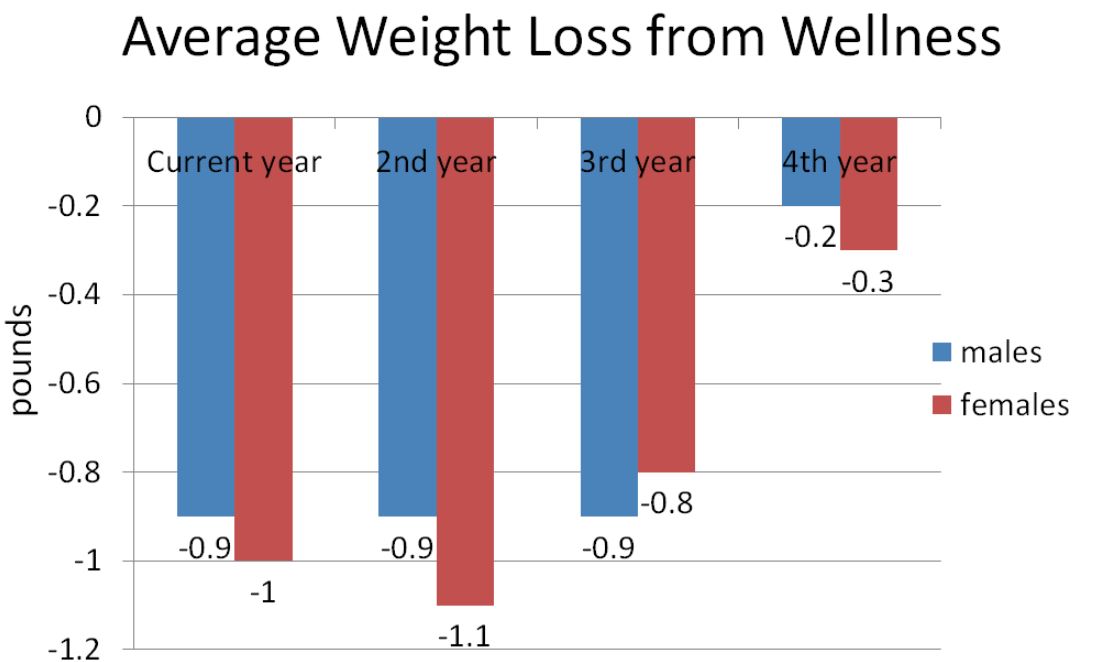
Source: Rand Report
If the focus of your well-being program is to help individuals reach and maintain a healthy body weight, you should prepare yourself to be disappointed. The unhealthy culture that surrounds most of us makes it extremely difficult to lose weight. In fact, most people in the United States and in the industrialized world gain weight every year.
So, there’s a couple ways to look at this. Well-being programs are very effective at reducing elevated health risks like blood pressure, glucose, and cholesterol. But they are not very effective at helping people lose weight.
Without the impact of all the well-being programs in the world, obesity would be even worse than it currently is.
Well-being programs may not help your employees reach a healthy body weight but it looks like they are helping your employees to stop gaining weight.
3) Well-being Programs Reduce Health Care Costs
There are nearly 100 different studies that have looked at the financial impact of well-being programs. These studies are not easy to do, they require extremely complicated ROI calculations, and they take years to complete.
In 2001, the most comprehensive review ever completed on the financial impact of worksite well-being programs was published. That study alone reviewed 100 different research papers. The ability of a well-being program to reduce healthcare costs depends upon how effective the program really is. Having an occasional lunch and learn about nutrition or just doing a biometric screening will not be enough to move the healthcare cost needle.
Comprehensive worksite well-being programs that improve employee behaviors will see a bending of the healthcare cost trend. Most often they will discover that the savings from program participation will be greater than the actual cost of the program. Almost every one of these return on investment (ROI) studies show a positive return on investment. Researchers from Harvard recently published another summary of the well-being ROI research.
Here is what they found:
| Study Focus | Number of Studies | Average Study Length | Average ROI |
|---|---|---|---|
| Health Care Costs | 22 | 3 years | 3.27 |
Source: Health Affairs
Among the 22 different studies that looked at well-being programs and healthcare costs, the average return on investment was 3.27. This means that for every dollar that was spent on the program the company saved $3.27 because of reduced healthcare costs.
Last year, researchers evaluated the impact of the WellSteps well-being program at a large school district. Here is the actual healthcare cost trend for this worksite. After four years of well-being this worksite is actually spending less on healthcare costs than it did before the program began. For every dollar they spent on well-being they saved $3.3.
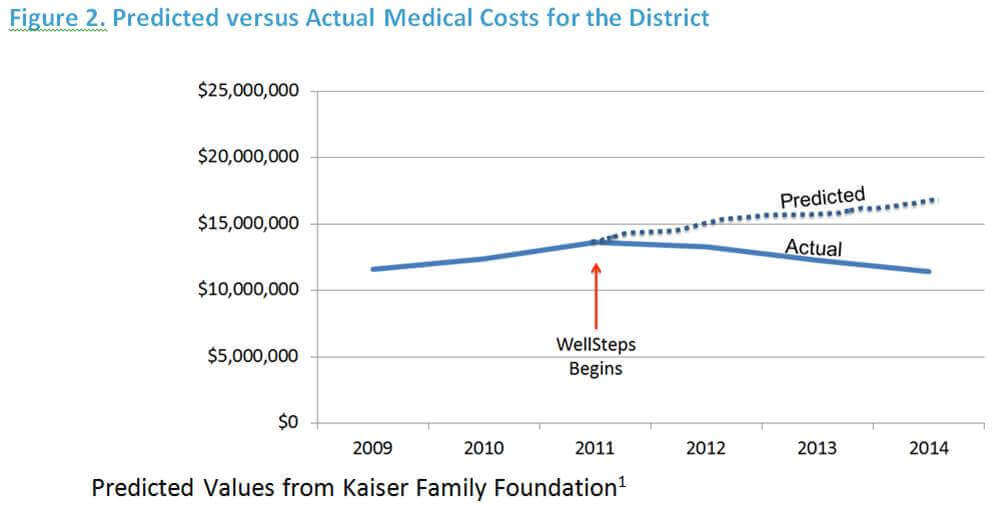
Source: Merrill et al. 2015
Anyone who still thinks well-being programs don’t improve health is choosing to completely ignore hundreds of peer-reviewed scientific research papers that say otherwise.
4) Well-being Programs Improve Productivity
Poor employee productivity can be defined as physically being at work but not working. This type of poor productivity is called presenteeism. It is estimated that the cost associated with presenteeism due to poor employee health is at least 2 to 3 times greater than direct health care expenses.
While the estimated cost of presenteeism dwarfs the cost of health care, it does not receive the same level of scrutiny among employers preoccupied with controlling the direct costs of poor employee health.

There are a lot of reasons why employees have low productivity. They may not use the equipment properly, get distracted by other employees, lack knowledge, feel tired, or browse social media. One of the main causes of presenteeism is poor health.
New understanding of presenteeism has been revealed in recent research published by the journal Population Health Management.
Smokers were 28% more likely to have high presenteeism than non-smokers. Employees with an unhealthy diet were 66% more likely to have high presenteeism than those who regularly ate whole grains, fruits, and vegetables.
Employees who didn’t exercise very much were 50% more likely to have high presenteeism than employees who were regular exercisers. These findings show that poor health behaviors strongly correlate with high levels of presenteeism.
In short, unhealthy individual lifestyle choices may result in substantially higher levels of lost productive work time.
This figure displays increased rates of high presenteeism among employees who smoke, don’t eat healthy, or don’t exercise regularly. Poor health behaviors eventually lead to elevated health risks and chronic diseases.
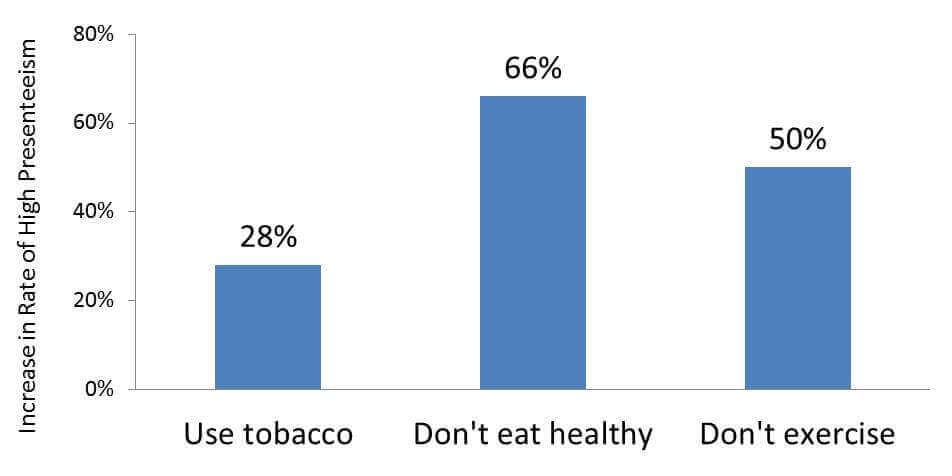
The figure below shows how health risks such as excess body weight, elevated blood pressure, and high cholesterol increased the odds of having high presenteeism.
The other health conditions in this figure further paint the presenteeism picture—the presence of risk factors, pain, and chronic disease, especially chronic depression, dramatically increase the odds of having high presenteeism.
Looking at this graph, you can see that employees who suffer from neck/back pain are 79% more likely to have high presenteeism than employees who do not have neck/back pain.
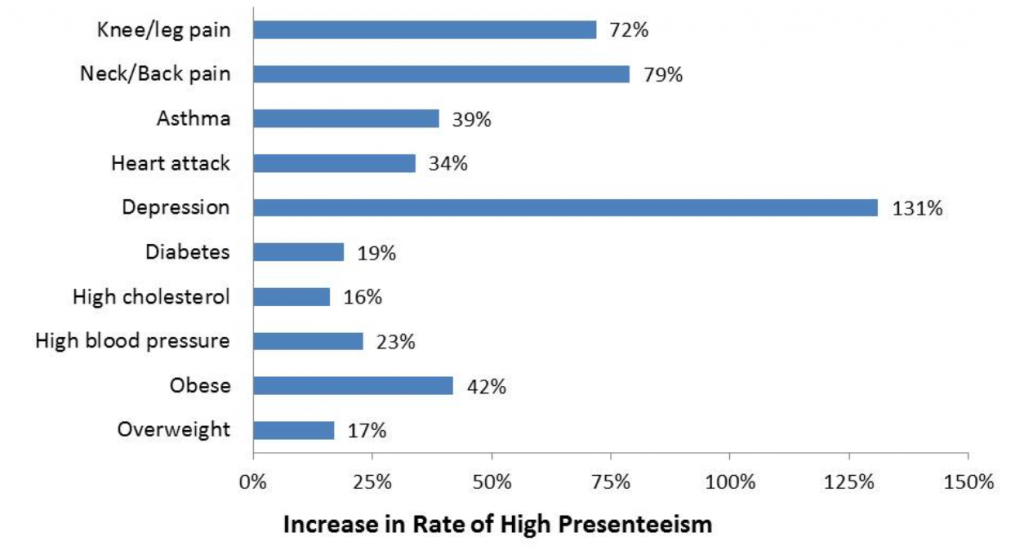
These results confirm several ideas about the benefits of well-being. Poor health behaviors, elevated health risks, and chronic disease are all linked to presenteeism.
Well-being programs that focus on helping employees have good health behaviors will eventually have an impact on productivity. You can read about the connections between worksite well-being and productivity in a previous blog.
5) Well-being Programs Can Decrease Absenteeism
There are over 50 papers that have looked at the connections between worksite well-being programs and reduced absenteeism. Worksites with comprehensive well-being programs can experience reduced absenteeism for a variety of reasons:
- Employees with good health behaviors have lower absenteeism.
- Employees who can control their stress have lower absenteeism.
- Employees with healthy blood pressure, cholesterol, and glucose have lower absenteeism.
- Employees who are a a healthy weight have lower absenteeism.
I summarized all of these studies in one monster paper that was published a few years ago. You can read the nitty-gritty details of all 46 papers if you’re really curious.
Any well-being program that can reduce absenteeism will experience cost savings. Harvard researchers looked at the ROI of well-being programs as they relate absenteeism and demonstrated that for every dollar well-being programs spend on well-being, they can save $2.73 and reduce absenteeism.
| Study Focus | Number of Studies | Average Study Length | Average ROI |
|---|---|---|---|
| Absenteeism | 22 | 2 years | 2.73 |
Source: Health Affairs
Well-being programs have the ability to improve employee health, and this can have an impact on whether or not individuals are absent from work. But there is another reason why well-being programs can have such a large impact on absenteeism. Employees who have high morale are significantly less likely to be absent from work.
6) Well-being Programs Can Help Improve Employee Recruitment and Retention
I confess there is no published scientific data that shows that well-being programs will make a significant impact on your ability to recruit and retain employees. There are a lot of factors that go into the decision to accept a job offer. It helps if you can offer a good salary and a rich benefits plan.
I had the privilege of visiting the VP of benefits at the Microsoft corporate office in Redmond Washington. If you are fortunate enough to land a job at Microsoft, you will get an amazing Microsoft benefits package.
You’ll get free well-being, free gym membership, onsite health clinics of every variety, and NO insurance premium—doesn’t that sound great? All the large software/tech companies are offering well-being with their benefits plans. The do this because they are all fighting with each other to hire and retain the best workforce possible. A rich benefits package makes it easier to get the best employees.
I don’t have any evidence that shows that having a well-being program will tip the scales when an employee is considering accepting a job. A Virgin HealthMiles/Workforce survey did find that about 87% of employees said they consider health and well-being offerings when choosing an employer. But compared to other defined benefits, well-being plans just don’t have much sway in the employment decision process.
However, well-being programs do have a strong impact on retention. Retention is the ability a worksite has to retain its workforce. Rich benefits also have a powerful influence on retention, but a good well-being program can help keep employees loyal.

Personnel is the most important asset in every organization. When an employer offers a well-being program to its employees the company is saying, “We think you are an important part of this organization and we want you to be healthy, happy, and employed here for a long time”. When you offer your employees a well-being program, you are showing them that you care about them.
You are letting them know you want to do everything you can to keep them in good health and optimal performance. Employees recognize when their company appreciates them. They know when feel welcome and valued as important parts of the organization.
That recognition can strongly influence employees to stay, even if they know they could find another job elsewhere.
7) Well-being Programs Build and Help Sustain High Employee Morale
I’m going to let you in on a little secret. The WellSteps Well-being solutions has a performance guarantee. After three years, we guarantee that your well-being program will have a positive return on investment. The secret is that after three years almost nobody cares about the ROI.
That may have been a good reason to start their well-being at work program, but after employees start to engage, communicate with each other, feel valued and appreciated, the reasons for doing a well-being program change. After three years we have found that our clients like to do well-being because they like the way it has changed their worksite culture.
Employees are obviously healthier but more importantly, they are happier. This is another reason that doesn’t have scientific research to back it up. We are probably never going to have a good study that can evaluate that question.
What we do have, however, is experience with hundreds of clients that have migrated away from the ROI of well-being and have moved towards the value on investment (VOI) of well-being. You can read a previous blog here.

The academic approach to well-being at work programs has limitations when we start talking about employee morale. As an internal observer, it is easy to see how our own well-being program impacts employee – but it is still difficult to measure and evaluate. Employee morale is a huge factor in the success or failure of any business and a good well-being program helps employees be happy and healthy.
Many of you have probably studied Maslow’s needs hierarchy. The pyramid shown below shows the different needs that we have as humans. The most important and life sustaining needs are the bottom of the pyramid, the base of the pyramid.
These include things like food, water, shelter, social interactions, etc. If we don’t fulfill these basic needs, we could die or struggle through life. The top half of the hierarchy shows what we want after meeting our basic needs. Not everyone gets to fulfill these higher needs, and their lives are not as rewarding as they could be.
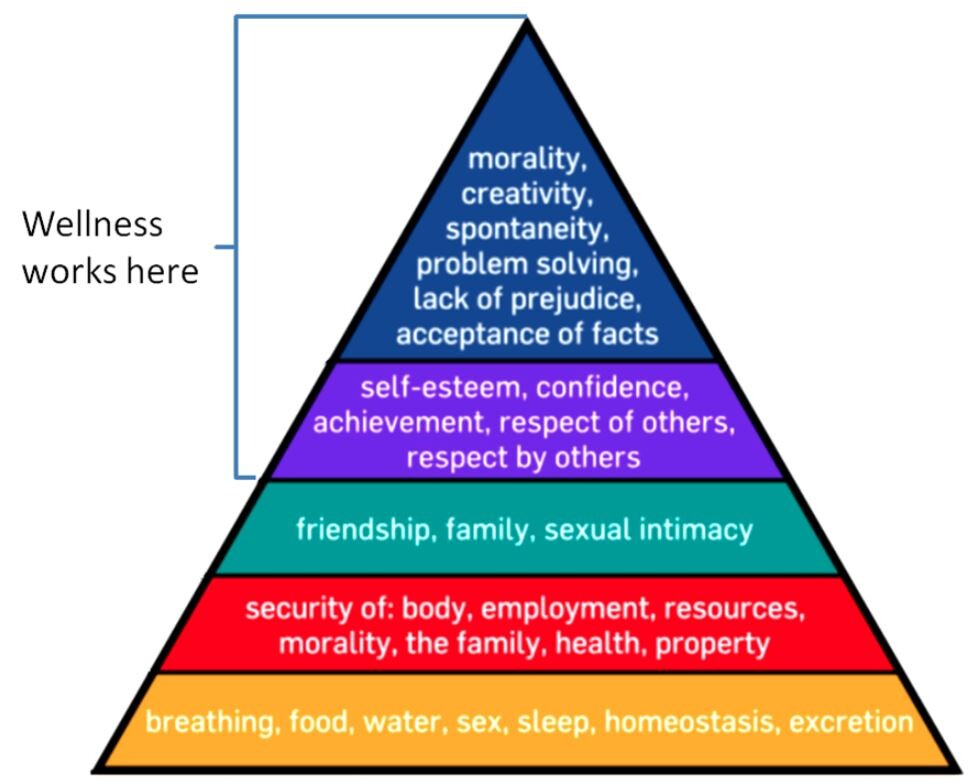
Why is employee well-being important? When you offer your employees a well-being at work program, you are telling them that you respect them, you trust them, and that you want to help them be successful in life. Employees have high employee morale when they are allowed to be creative, solve problems, feel safe and appreciated, develop self-esteem, and achieve personal goals and aspirations. Employees are happy when they have a sense of control over their lives and their health.
In my opinion. this is one of the most powerful reasons to have a well-being program. Realistically, your employees don’t care about your healthcare cost problem, they care about their own happiness. Your employees don’t share your concerns about productivity or absenteeism. They care about having a fulfilling, enjoyable job.
Your well-being at work program helps employees achieve all of their needs, both physical, social, and emotional. When it is all said and done, your employees want to feel loved and appreciated, and when they do really good things happen at work.
Productivity goes up, customer service is outstanding, problems get solved, and people get creative. They like coming to work, they appreciate their employer, they work better with others, and they have high employee morale.
What is the financial value of having employees with high morale? It’s probably impossible to make this calculation, but reverse the question and ask it again.
What does it cost your company when you have employees with poor morale? Complaints will go up, the quality of your product or service will suffer, and problems will multiply because poor employee morale can be contagious. Poor employee morale can be a company killer.
There is no question that high employee morale, while almost impossible to evaluate, is an extremely important benefit of well-being at work. Perhaps this is why many of the companies with outstanding well-being programs have dramatically better financial performance.
So What?
There is an enormous amount of research to support the benefits of well-being. A comprehensive well-being program is going to improve employee health and improve your organization’s bottom line.
It is not going to make all your problems go away, but it is going to help you create a worksite culture of health. It will boost and maintain employee morale. With an effective well-being program, you will improve the lives of your employees and help drive the success of your organization. Not sure where to start still? Check out The 18 Most Popular Workplace Well-being Programs.
[maxbutton id=”1″ ]


To say that promoting wellness in the workplace is important would be an understatement. For example, someone who works an office job may be sitting in front of their computer for hours on end. This can have negative implications in the long run, so offering well-being programs, such as rewards through fitness apps, helps with promoting health.
Comments are closed.